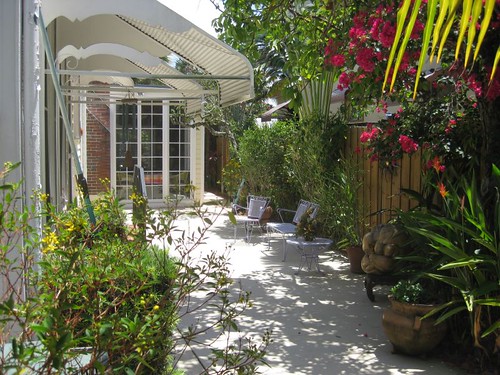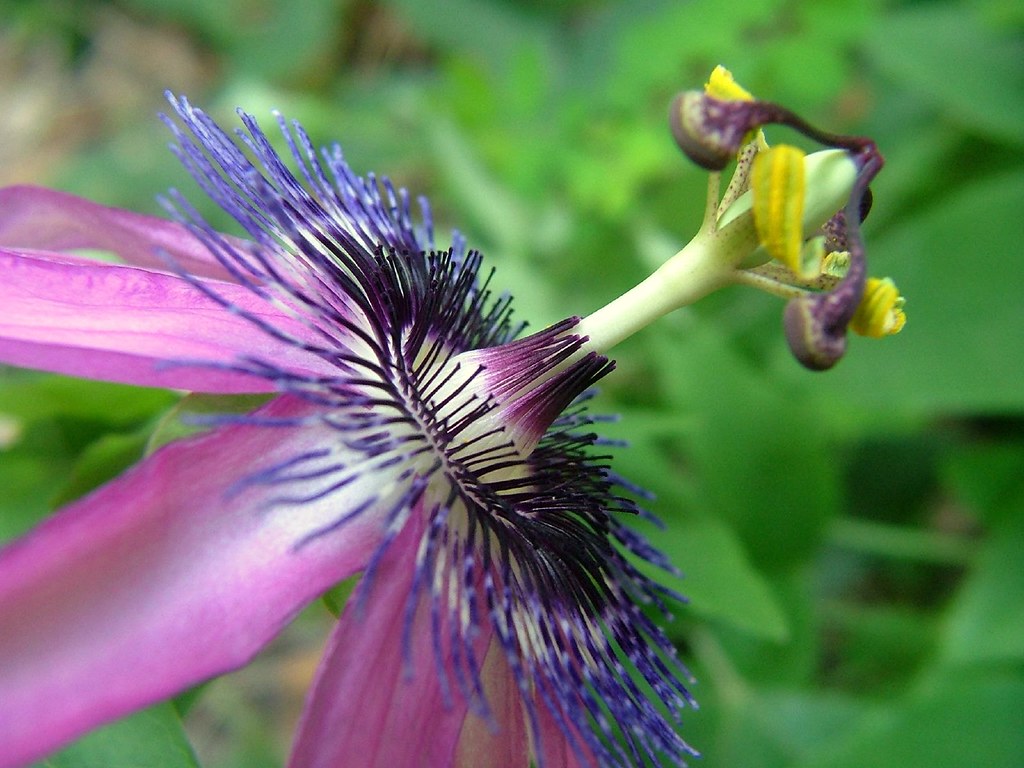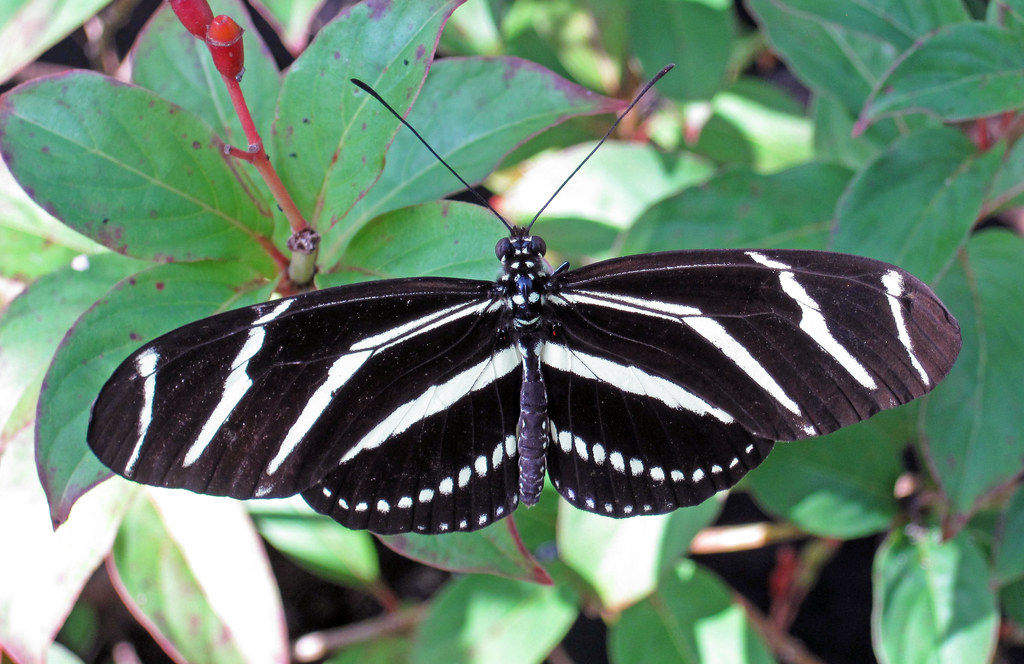A Florida butterfly patio garden is a garden space specifically designed to attract and support butterflies. It is created on a patio or balcony, making it accessible to individuals with limited outdoor space. The primary goal of a patio butterfly garden is to provide a habitat that attracts butterflies, encourages their visitation, and supports their life cycle.

Here are some key elements and considerations for creating a patio butterfly garden (depending on which of the Florida Gardening Zones you reside in):
- Plant Selection: Choose a variety of plants that are known to attract butterflies. These include nectar-rich flowering plants like milkweed, butterfly bush (Buddleia), zinnias, lantana, pentas, coneflowers (Echinacea), and salvias. Plant both annuals and perennials to ensure a continuous supply of nectar throughout the season.
- Host Plants: Incorporate host plants in your patio garden. Host plants are specific plants on which butterflies lay their eggs, and the resulting caterpillars feed on the foliage. For example, milkweed is the host plant for monarch butterflies. Adding host plants supports the complete life cycle of butterflies in your garden.
- Water Source: Provide a shallow water source, such as a butterfly water dish or a shallow dish filled with water and stones. Butterflies need water for drinking and to extract nutrients.
- Shelter and Perches: Incorporate elements like rocks, logs, or branches in your patio garden to create resting spots and perches for butterflies. These structures also offer shelter from wind and predators.
- Sunlight: Most butterfly species prefer sunny areas for feeding and basking. Ensure your patio garden receives ample sunlight for a significant portion of the day.
- Avoid Pesticides: Minimize or avoid the use of pesticides in your patio butterfly garden, as they can harm butterflies and their larvae. Instead, focus on natural pest control methods and creating a balanced ecosystem.
- Continuous Blooming: Select plants with staggered or overlapping bloom times to provide a constant supply of nectar throughout the season, attracting butterflies at different stages of their life cycle.
- Education and Observation: Consider incorporating educational elements in your patio butterfly garden, such as informational signs or resources about the life cycle of butterflies. This encourages learning and appreciation for these winged creatures. This is especially great if you have children in your house and neighborhood.
Creating a patio butterfly garden not only beautifies your outdoor space but also contributes to the conservation of butterfly populations. It provides a haven for these enchanting insects while offering an opportunity to observe and appreciate their behavior up close.
What plants should a Florida Patio Garden have to attract butterflies?
To attract butterflies to your Florida patio garden, it’s important to include plants that provide nectar as a food source for adult butterflies. Here are some plant suggestions that are known to attract butterflies in Florida:

- Milkweed (Asclepias spp.): Milkweed is essential for monarch butterflies as it is their sole host plant. Common varieties in Florida include Swamp Milkweed (Asclepias incarnata) and Butterfly Weed (Asclepias tuberosa).
- Pentas (Pentas lanceolata): Pentas produce clusters of small, star-shaped flowers that are highly attractive to butterflies. They come in various colors and bloom throughout the warm season.
- Lantana (Lantana camara): Lantana is a popular choice for attracting butterflies in Florida. It produces clusters of small, colorful flowers and can tolerate hot and dry conditions.
- Coneflowers (Echinacea spp.): Coneflowers are not only beautiful but also provide nectar for butterflies. Purple Coneflower (Echinacea purpurea) and Pale Purple Coneflower (Echinacea pallida) are native varieties in Florida.
- Blanket Flower (Gaillardia pulchella): Blanket Flower is a colorful, daisy-like flower that attracts butterflies with its nectar. It thrives in Florida’s sunny conditions.
- Gregg’s Mistflower (Conoclinium greggii): Gregg’s Mistflower is a native perennial with clusters of small, lavender flowers that butterflies find irresistible.
- Firebush (Hamelia patens): Firebush is a Florida native shrub with tubular, red-orange flowers that attract butterflies and hummingbirds.
- Salvia (Salvia spp.): Salvias, such as Mexican Sage (Salvia leucantha) and Scarlet Sage (Salvia coccinea), are nectar-rich and highly attractive to butterflies.
- Butterfly Bush (Buddleia davidii): While not native to Florida, butterfly bushes are commonly planted for their ability to attract butterflies. They produce large clusters of fragrant flowers in various colors.
- Passionflower (Passiflora spp.): Passionflowers serve as host plants for several butterfly species and produce unique and beautiful blooms. The Gulf Fritillary butterfly is particularly fond of Passionflower (Passiflora incarnata).
By including a variety of these plants in your Florida patio garden, you can provide nectar sources for butterflies throughout the year, attracting a diverse range of species. Remember to provide sunny locations, appropriate soil, and regular watering to support the growth and blooming of these plants.
What species of butterflies are common to Florida?
Florida is home to a diverse range of butterfly species due to its warm climate, varied ecosystems, and abundant plant life. Here are some common butterfly species you may encounter in Florida:

- Monarch Butterfly (Danaus plexippus): Monarchs are well-known migratory butterflies that pass through Florida during their annual migrations. They rely on milkweed plants as their host for egg-laying.
- Gulf Fritillary (Agraulis vanillae): Gulf Fritillaries are medium-sized butterflies with bright orange wings adorned with black markings. They are commonly seen in Florida and have a preference for Passionflower plants as their host.
- Zebra Longwing (Heliconius charithonia): The Zebra Longwing is the official state butterfly of Florida. It has distinctive black wings with narrow yellow stripes. This butterfly feeds on nectar from a variety of flowers and lays eggs on Passionflower vines.
- Eastern Tiger Swallowtail (Papilio glaucus): The Eastern Tiger Swallowtail is a large butterfly with striking yellow and black markings. It is commonly found in Florida and visits a wide range of nectar plants.
- Black Swallowtail (Papilio polyxenes): The Black Swallowtail has black wings with vibrant yellow markings. It is commonly seen in Florida and is known to use plants like dill, parsley, and fennel as host plants.
- Great Southern White (Ascia monuste): The Great Southern White is a medium-sized butterfly with white wings and black markings. It is a common sight in Florida and lays eggs on plants in the mustard family.
- Cloudless Sulphur (Phoebis sennae): The Cloudless Sulphur is a bright yellow butterfly that is often seen flying in open areas and gardens. It is attracted to nectar-rich flowers like lantana and zinnia.
- Florida White (Appias drusilla): The Florida White is a small butterfly with white wings and black markings. It is native to Florida and uses plants in the mustard family as host plants.
- Julia Heliconian (Dryas iulia): The Julia Heliconian is a vibrant orange butterfly with black markings. It is commonly seen in southern Florida and feeds on nectar from various flowers.
- Painted Lady (Vanessa cardui): The Painted Lady is a migratory butterfly that can be found in Florida. It has distinctive orange and brown wings with black and white markings.
These are just a few examples of the many butterfly species that can be found in Florida. The state’s diverse ecosystems provide habitats for a wide array of butterflies, making it a great place for butterfly enthusiasts and nature lovers to observe and appreciate these beautiful insects.
My name is Kevin. I’ve been patio gardening in Florida for about 8 years, and for another 20 before that in New York. Happy to have you here on my website!

Leave a Reply